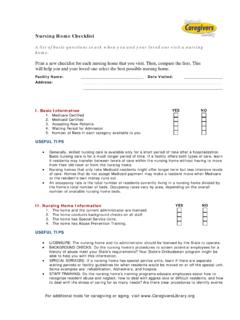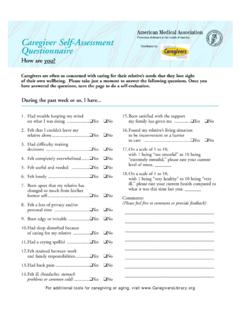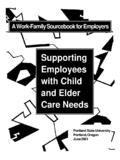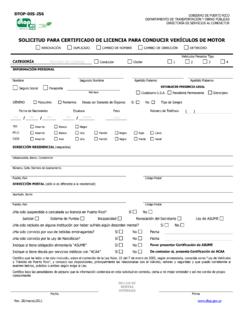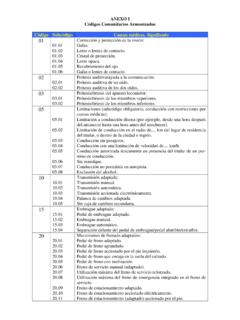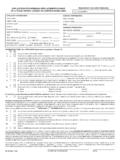Transcription of Driving Assessment Checklist - Caregivers Library
1 For additional tools for caregiving or aging, visit Assessment Checklist If you are unsure about your loved one s ability to drive, this Checklist can help Asking an elderly parent or relative to stop Driving is difficult, because Driving provides individuals with the ability to remain independent. Yet, many elderly (65 years and older) drivers are a danger to themselves and others on the road. It s important, therefore, that the family, friends, and other Caregivers of these individuals be able to identify potential Driving problems and to request that the person stop any dangerous Driving behavior. For some individuals, this may be as simple as Driving only on certain kinds of roads ( , no highways) or Driving only during daylight hours. For more dangerous drivers, however, it is important that the individual stop Driving altogether, and find other transportation options that will provide him or her with continued independence.
2 If your loved one s Driving worries you or if you are unsure whether your loved one should continue to drive you will probably want to perform a specific Assessment before talking to him or her about the problem. Below is a list of items. Check yes if any item applies to your loved one: Driving Assessment Checklist YES NO 1. A police officer has given your loved one a warning because of poor Driving behavior. 2. Your loved one s record shows a pattern of close calls, violations, and/or minor collisions. 3. Driving makes your loved one nervous and anxious. 4. It is difficult for your loved one to look over his or her shoulder or to turn his or her head to the side to look before changing lanes. 5. Driving makes your loved one tired very quickly. 6. Your loved one has trouble climbing stairs or walking more than one block in a day.
3 7. Your loved one often becomes disoriented about where he or she is in relation to home when Driving . 8. Making good decisions quickly is difficult for your loved one when he or she is Driving . For additional tools for caregiving or aging, visit Your loved one has difficulty with the glare of oncoming headlights, streetlights, or other shiny objects while Driving during the day or at night. 10. Your loved one has a difficult time seeing people, traffic signs, lane lines, or other objects around or on the road. 11. Your loved one often visually misses red lights or stop signs and as a consequence goes through them. 12. Your loved one backs into and over things such as curbs. 13. Passing cars frighten your loved one due to their noise or speed. 14. Other drivers tailgate or pass your loved one most of the time.
4 15. Your loved one has a difficult time with hand/foot coordination. 16. Your loved one has mistaken the gas for the break. 17. Your loved one has had a stroke, or has amyotrophic lateral sclerosis (ALS), dementia, epilepsy, multiple sclerosis, Parkinson s disease, seizure or sleep disorders, or uncontrolled diabetes. 18. Your loved one takes medication for a prior stroke, or for amyotrophic lateral sclerosis (ALS), dementia, epilepsy, multiple sclerosis, Parkinson s disease, seizure or sleep disorders, or uncontrolled diabetes that could affect his or her Driving ability. 19. Your loved one s drivers license was not checked when he or she turned age 70. 20. Your loved one s drivers license has not been checked every three years since he or she turned 70 ( , 73, 76, 79) or annually since he or she turned 80.
5 Although there is no specific number of times that you can answer yes before your loved one should no longer drive, answering yes to multiple items suggests that you might want to talk with your loved one about his or her Driving , and to look into alternative transportation options. Copyright FamilyCare America, Inc. All Rights Reserved.

